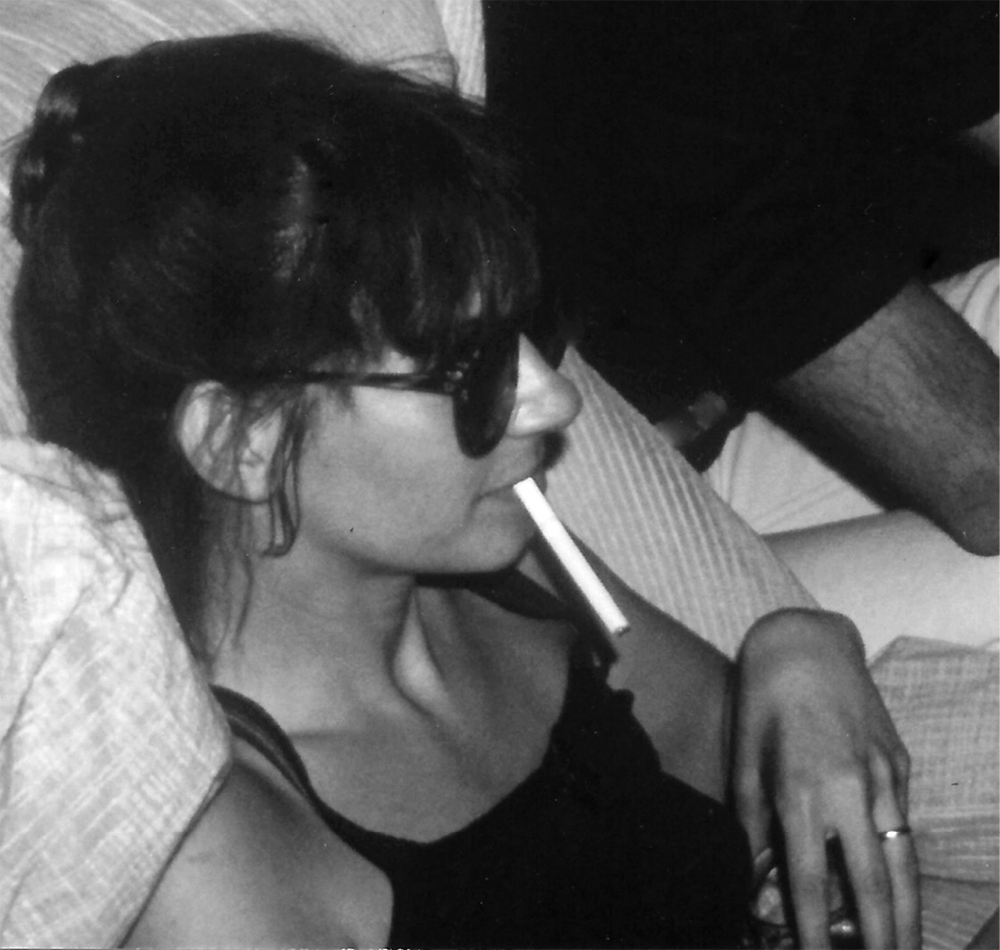Issue 248, Summer 2024

Mansfield, Connecticut, 1973. All images courtesy of Elaine Scarry.
Elaine Scarry lives in a pale pink house near the Charles River in Cambridge, Massachusetts. A tall hedge runs along the front, rising to the second story and nearly engulfing the white picket gate through which one passes into Scarry’s garden. Flowers thrive in dense beds overlooked by crabapple trees and yews. Toward the back of the house, a curved wall of windows divides the garden from the garden room. Scarry’s longtime partner, the writer and scholar Philip Fisher, keeps a house nearby and they split their time between the two. Fisher does the cooking, and they eat dinner at his place. When it’s nice out they like to go for a drive.
Both teach a few blocks away in Harvard’s English department, where they’ve been on the faculty for more than thirty years. Scarry’s title is Walter M. Cabot Professor of Aesthetics and General Theory of Value. Since The Body in Pain (1985), her iconic debut examining language in the context of torture and war, she has published eight books spanning literary criticism, moral and political philosophy, social theory, cognitive psychology, and neuroscience, sometimes within the same volume. She has spoken at numerous law and medical schools. To each discipline she brings uncommon perceptions. In an early presentation at the Yale Legal Theory Workshop, she analyzed the Amtrak emergency brake as an ideal model of consent, since any passenger can pull it, whereas only the driver or the pilot can stop a car or a plane. Her study of imagery in poems and novels argues that flowers appear so often in literature because they are perfectly sized to fit “the habitual space of interior imagining—the forehead.” Some were incredulous when she published essays in The New York Review of Books hypothesizing that electromagnetic interference caused plane crashes, but a 2000 NASA report begins by crediting her for prompting its own investigation. Scarry’s most recent book claims to reveal the secret addressee of Shakespeare’s sonnets.
Scarry’s home is furnished simply, but ornaments abound. Clusters of bright glass bottles and vases congregate on shelves and windowsills. In one vase (striped aqua), live poppies mingle with blond plumes of dry grass and a forked branch cradles an abandoned bird’s nest. A side table displays two tiers of shells organized by size and type—conches, large scallops, small scallops, clams. The formation recalls the grid of birds’ eggs on the cover of On Beauty and Being Just (1999), which explores the ways encounters with beauty lead us to seek social justice. The “strange brown green” of that cover is very difficult for printers to get right, she told me: one run had to be pulped.
For some years now, Scarry has been writing a book called “Imagining Color,” on how poets and novelists enact that process on the reader’s “mental retina.” But lately she’s devoted much of her energy to her work against nuclear weapons: a piece about why “nuclear weapons sabotage not just constitutions but the actual capacity for philosophic thinking”; a new preface to a Japanese translation of Thermonuclear Monarchy (2014); Zoom meetings with Peace Action groups around the country.
We met four times between 2022 and 2023, sitting in the garden room for long conversations occasionally interrupted by the sound of a glass harmonica (her landline ringtone). Scarry’s speaking style bears some relation to her decor—delicate variations, parallel arrangements—and her sentences manifest an intricate syntax of examples, hypotheticals, and asides. She is, in all things, meticulous and conscientious. Over email this spring, she described being stranded in Alabama during a tornado warning: “With amazing good luck (for someone who has written about ‘thinking in an emergency’) the tornado-proof room in which I was hiding out (the only hotel guest, the receptionists told me, who followed the instructions blaring on everyone’s phones) was suddenly entered by thirty Coast Guard emergency swimmers who were gathering for a pre-arranged all-afternoon meeting and welcomed me into their midst.”
INTERVIEWER
Not many literary scholars have written books on torture, war, and nuclear abolition. How do you see the two sides of your work fitting together?
ELAINE SCARRY
I see my writing on imagination and on war as continuous. Or rather, the two subjects are essentially locked in combat, because the act of inflicting injury or pain is really a willful aping of imagination, turning it upside down and appropriating it. The Body in Pain and On Beauty and Being Just are about both willful injuring and creation, but I’m sometimes writing about just one or the other—as in, let’s say, the articles on electromagnetic interference for The New York Review of Books, or, on the other hand, when I look at verb forms in Emily Brontë. But because they’re parts of a larger architecture, they seem to me to go together.
I’m dedicated to the factual, and yet one has to have a tremendous capacity for factual and counterfactual thinking to be able to see any truth at all. And the exercise of the counterfactual is really done through literature. I once had the occasion to write about Orwell’s 1984, for a book that Martha Nussbaum and some of her colleagues edited. People always talk about the way, in that novel, the state destroys facts in order to incapacitate any kind of objection—but the state is also trying to dismantle the imagination through the Fiction Department, where machines write novels and where Winston Smith’s beloved Julia works. If you really want to take down someone’s, or a whole population’s, ability to think, you must do it by shutting down their practice of the fictional as well as their practice of the factual.
INTERVIEWER
How does studying literature help us think?
SCARRY
What we often do in a literature class is talk about the psychological or philosophic complexities of a text. But anterior to the discussion of the psychology and the moral or ethical questions and all the other interesting reasons we’re motivated to read literature is this thing we have to do to construct the world of the book in our minds—not just like a lazy daydream, but as an incredibly complex landscape of interactions.
So many people who are considered towering intellects have talked about the contributions that came to them from reading literature. Oppenheimer was not only reading Sanskrit but could recite passages of Proust verbatim. Thomas Hobbes translated the Iliad and the Odyssey, and Newton said that having to deal with physics and math was an interruption of his real study, which was of the Bible. Now, Newton thought the Bible was historically real, but that doesn’t change the fact that it’s a narrative and he had to make the steady cascade of images in his mind. I’m a slow reader myself, and it takes me many, many hours even to reread a book, but I think it’s unfortunate that less and less reading is required of students these days. You just wonder, How are people going to do all they wish to do without this power of the mind acquired through Olympic feats of reading?
INTERVIEWER
Dreaming by the Book (1999) is a detailed analysis of how we make those images. Would you call it a work of philosophy or of criticism?
SCARRY
It may be something like phenomenology coupled with theory of mind.




